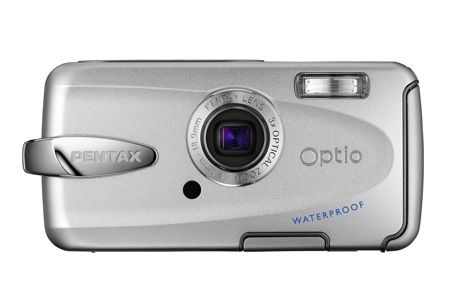Pentax are not the only manufacturer making robust, water and dust proofed cameras, Pentax seemingly vying with Olympus, the other notable maker building digital compacts that can be used in all weathers or underwater without a housing.
Our quick take
Tough, versatile, and easy to use the Pentax Optio W30 offers a neat combination of rugged outdoorsiness along with scene modes comprehensive enough to provide shooting panache.
Some sluggish AF problems aside, the W30 is well worth looking at if you want a camera that can go anywhere you do, rain, snow, sand shine or swim!

Pentax Optio W30 digital camera - 4.0 / 5
| FOR | AGAINST |
|---|---|
|
|
The latest Pentax offering is this, the Optio W30, a camera that provides a 7.1-megapixel sensor and a body waterproofed to a depth of 3 metres plus dust proofing that can keep particles out of the system as fine as talcum powder, so use in dust storm or at the beach should be no problem at all.
The predominantly metal body has rubber seals over all the main (self locking) hatches and ports for battery, memory card, USB and DC-in ports. The body sports a large 2.5-inch colour screen with a new anti reflective coating, however that coating is not as effective as I’d have liked or have seen on other cameras. Reflections in bright conditions still proved a problem and of course, as with most large screened digital compacts today, there’s no optical viewfinder.
The camera’s 3x optical zoom lens has a 38-114mm focal range and sits behind a specially coated glass cover that prevents water drops from collecting on the glass – it works well. Using the camera in rain and underwater in this test, I found water simply ran straight off the coated glass and there were no problems with droplets of water distorting the images you shoot.
The camera’s silver liveried metal body is smooth, slim and with sculpted round corners that make it sit neatly in the hand. A lozenge shaped metal logo on the face doubles as a grip surface and camera strap lug. The rechargeable battery and SD/SD-HC//MMC memory card slot cover is weaker as it is made from plastic, as is the small cover over the AV/USB and DC-in cover on the base, but otherwise, the camera feels as solid as a rock.
This sleek bodywork makes handling the camera a slippery affair however, particularly underwater where the wrist strap becomes essential and compounded by the slightly awkward positioning (for my fingers at least) of the shutter release which sits to far over on the camera’s shoulder to use comfortably and grip the camera firmly.
Sets of controls on the back plate include the usual four-way jog buttons and OK button along with a menu button, playback, zoom control and a Green button. The Green button quickly switches the camera from the mode you’re shooting in to the basic, point and shoot setting where the camera does the “talking” leaving you to do the walking or swimming or climbing or whatever you want in fact, given the ruggedness of the camera body.
Flash, macro and selftimer modes are selected via the four-way jog button (which also scrolls menus and images in playback mode) with the flash system benefiting from a new soft-flash option to stop overexposure and bleaching out of subjects during close up shots for example and the camera’s many shooting modes selected by the fourth Mode jog button. Here you get 25 shooting options that include the normal range of portrait, landscape, night scene modes and a 640 x 480-pixel movie mode at 30fps that also benefits from the cameras rather misleadingly named anti-shake system, more on which in a moment.
Other modes include an underwater movie mode, and an underwater still setting (of course), plus a sport, pet and a natural skin tone setting. The plethora of shooting so called scene options is designed to offer a broad base of shooting flexibility to cover most shooting situations because the camera lacks any other form of manual control over your exposures.
In terms of image quality, the Pentax performs well enough up to sensitivities of ISO 400, above this setting things get noisier (as you’d expect) but with a top ISO of 3200, by the time you ramp up the sensitivity to cater for, say, low light shooting with moving subjects you want to freeze, noise is a real problem. And it is this high sensitivity setting the camera uses for its anti shake system, so it is not an anti shake system per se, but like other makers who use this type of blur reduction, it as really a software anti shake solution. This actually just bumps up the ISO and along with the noise issues associated with higher sensitivities making images very noisy indeed.
Metering is however, very reliable as is white balance and colour capture, the white balance working well – even the auto setting makes a good fist of mixed lighting – while the colour capture produces nicely rendered, natural looking images. The focus system was a little less dependable being slow to get going, particularly the focus tracking, which worked well for slower subjects but lacked speed tracking faster subjects although usefully it will track them right up to the edge of the frame.
On the up side the Face recognition AE/AF got things right and proved versatile when your subject is straight on to the camera. However, the sharpness of the lens is compromised as the default sharpness level is quite low, but this (like most of the other image options) can be tweaked in settings or adjusted later on PC in software if required.
To recap
It’s pocketable and simple to use but not without some flaws
